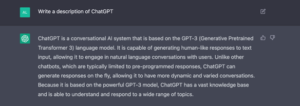
Comparing ChatGPT with traditional Enterprise Conversational AI
Conversational AI is all the rage now! ChatGPT from the research company OpenAI in California impresses with its ability to understand human language with unimaginable speed and with its ability to create advanced and insightful texts. In just a few weeks, millions of people have recognized its potential and ability to produce and edit content: writing novels, essays, school assignments, poetry, songs, correcting code etc.
At the same time, warnings come from several sides about reliability if you need accurate, fact-based answers.
Reliability is where the weakness lies, at least in the current state of the research project, when considering using ChatGPT professionally for companies in their customer service, internal communication, etc. For any reliable and serious business application, it is required that all answers given to customers and citizens are precisely correct and consistent. This is especially true in regulated industries, like banking, finance, insurance and the public sector.
How does ChatGPT compare to Enterprise Conversational AI Best Practices?
The Similarities between ChatGPT and traditional Enterprise Conversational AI
1) From a technical point of view, there are no principal differences. The Machine Learning model Natural Language Processing (NLP) is based on Neural Network Deep Learning. The prerequisites for understanding the questions people ask are thus similar.
2) Both solutions require manual training of data to function. “Self-Learning” is based on the principle of “Human-in-the-loop”.
The Differences between ChatGPT and Enterprise Conversational AI
1) State-of-the-art Enterprise Conversational AI has one single use case defined (F.ex. Internal or external Customer Service at an Organization) – ChatGPT, on the other hand, tries to complete “almost any language task”.
2) The ChatGPT answers are not entirely consistent and it can respond differently from time to time when asked the same question. Sometimes it is fairly accurate, but the answers differ over time. A professional Enterprise Chatbot is trained always to answer consistently and correctly. It is always trained in accordance with regulations and the specific organization’s practised response. If it doesn’t have the requested data, it replies that it doesn’t know and can’t make it up.
3) The amount of training data and number of human AI trainers differ as ChatbotGPT is trained with 300 Billion words by approximately 40 Full-time AI trainers over many years.
It is easy to get impressed by the humanlike and exceptionally crafted communication skills that ChatGPT shows thanks to GPT3, so this bot has received a lot of buzz lately due to its perceived wit and ability to create Novels, Essays, Lyrics etc.
A fun detail; What does the bot say about itself?

Gartner says in a blog post published on December 8, 2022:
Chatbots allow interaction in a seemingly ‘intelligent’ conversational manner, while GPT3 produces output that appears to have ‘understood’ the question, the content and the context. Together this creates an uncanny valley effect of ‘Is it human or a computer? Or, is it a humanlike computer?’ The interaction is sometimes humorous, sometimes profound and occasionally insightful.
Unfortunately, the content is also sometimes incorrect and never based on a humanlike understanding or intelligence. The training data used on the model determines the way questions will be answered. However, as noted earlier, GPT’s capability to unpredictably generate false information means that it can only be used for situations where errors can be tolerated or corrected.
Complexity: Large models involve billions, or even trillions, of parameters. These models are impractically large to train for most organizations because of the necessary computing resources, which can make them expensive and environmentally unfriendly.
Read the full Gartner post here https://www.gartner.com/en/newsroom/press-releases/2022-12-08-why-is-chatgpt-making-waves-in-the-ai-market
Our conclusion
What is certain is that OpenAI’s ChatGPT has made Conversational AI known to millions of people, and it can be a helpful tool assisting in content creation. However, we don’t see the direct commercial use of the ChatGPT in our specific field of expertise (at least yet) due lack of predictable and consistent organization-specific answers created by a manageable amount of AI training. We look forward to seeing how NLP technology evolves and improves digital communication between organizations and their customers.
At the same time, we are very excited that the already advanced language models continue to improve so that our future services will provide even higher value for our customers in many use cases, not requiring so precise and case-specific answers.